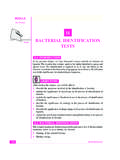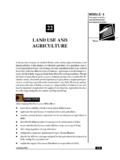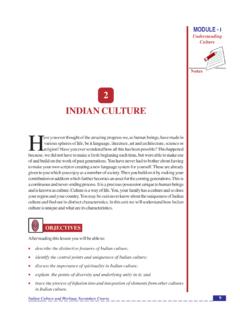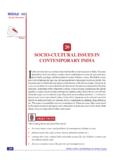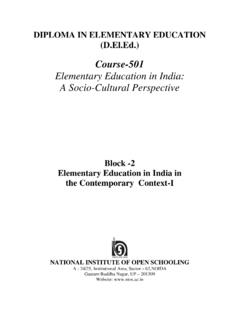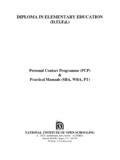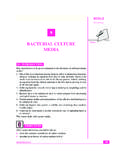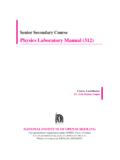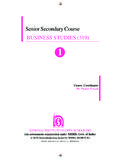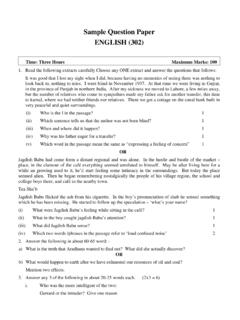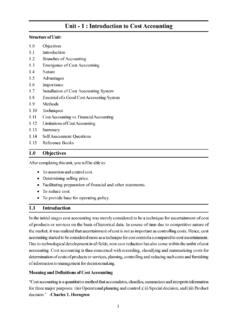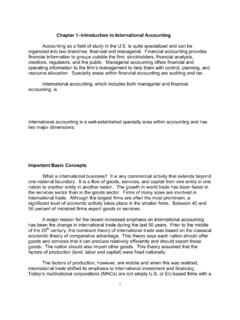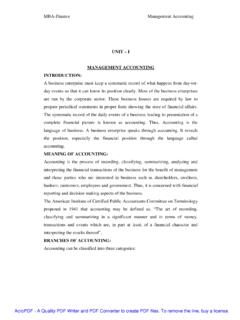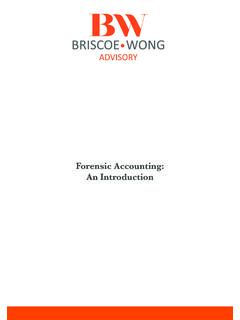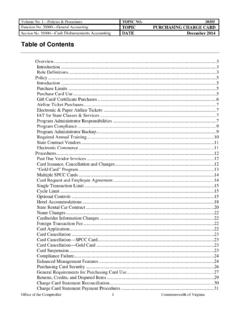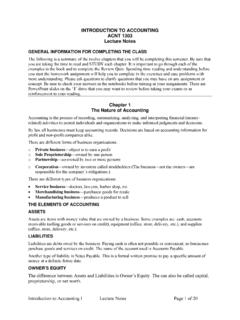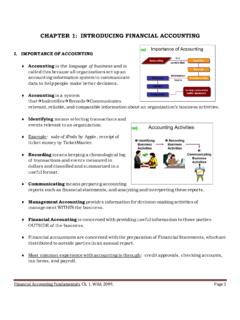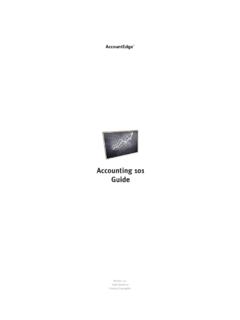Transcription of BASIC ACCOUNTING PRINCIPLES
1 DIPLOMA IN INSURANCE SERVICESMODULE - 1 NotesBasic ACCOUNTING PRINCIPLES Business Environment 605 BASIC ACCOUNTING INTRODUCTIONWe have studied economic activities which have been convertedinto business activities. In business activity a lot of give &take exist which is known as transaction. Transaction involvestransfer of money or money s worth. Thus exchange of money,goods & services between the parties is known to have resultedin a transaction. It is necessary to record all these transactionsvery systematically & scientifically so that the financialrelationship of a business with other persons may be properlyunderstood, profit & loss and financial position of the businessmay be worked out at a particular date. The procedure to recordall these transactions is known as Book-keeping .In other words the book keeping may be defined as an activityconcerned with the recording of financial data relating tobusiness operations in an orderly manner.
2 Book keeping isthe recording phase of ACCOUNTING . ACCOUNTING is based on anefficient system of book is the analysis & interpretation of book keepingrecords. It includes not only the maintenance of accountingrecords but also the preparation of financial & economicinformation which involves the measurement of transactions& other events relating to are various terminology used in the ACCOUNTING whichare being explained as under: -1) Assets: An asset may be defined as anything of use inthe future operations of the enterprise & belonging toMODULE - 1 Business EnvironmentNotes 61 BASIC ACCOUNTING PrinciplesDIPLOMA IN INSURANCE SERVICESthe enterprise. , land, building, machinery, cash ) Equity: In broader sense, the term equity refers to totalclaims against the enterprise. It is further divided intotwo Claim - Capitalii. Outsider s Claim LiabilityCapital: The excess of assets over liabilities of theenterprise.
3 It is the difference between the total assets& the total liabilities of the enterprise. ,: if on aparticular date the assets of the business amount to lakhs & liabilities to Rs. 30,000 then the capital onthat date would be ,000 : Amount owed by the enterprise to the to all others except the owner. ,: trade creditor,bank overdraft, loan ) Revenue: It is a monetary value of the products or servicessold to the customers during the period. It results fromsales, services & sources like interest, dividend & ) Expense/Cost: Expenditure incurred by the enterpriseto earn revenue is termed as expense or cost. Thedifference between expense & asset is that the benefit ofthe former is consumed by the business in the presentwhereas in the latter case benefit will be available forfuture activities of the business. , Raw material,consumables & salaries ) Drawings: Money or value of goods belonging to businessused by the proprietor for his personal ) Owner: The person who invests his money or money sworth & bears the risk of the ) Sundry Debtors: A person from whom amounts are duefor goods sold or services rendered or in respect of acontractual obligation.
4 It is also known as debtor, tradedebtor, accounts ) Sundry Creditors: It is an amount owed by the enterpriseon account of goods purchased or services rendered or inrespect of contractual obligations. , trade creditor,accounts IN INSURANCE SERVICESMODULE - 1 NotesBasic ACCOUNTING PRINCIPLES Business Environment OBJECTIVESAt the end of this lesson you will be ablezTo maintain the books of accountszTo prepare the annual ACCOUNTING CYCLEA fter taking decisions such as selecting a business, selectingthe form of organisation of business, making decision aboutthe amount of capital to be invested, selectingsuitable site,acquiring equipment & supplies, selecting staff, gettingcustomers & selling the goods etc. a business man finallyresorts to record all types of business organisations, transactions such aspurchases, sales, manufacturing & selling expenses, collectionfrom customers & payments to suppliers do take place.
5 Thesebusiness transactions are recorded in a set of ruled bookssuch as journal, ledger, cash book etc. Unless thesetransactions are recorded properly he will not be in a positionto know where exactly he following is the complete cycle of Accountinga)The opening balances of accounts from the balance sheet& day to day business transaction of the ACCOUNTING yearare first recorded in a book known as ) Periodically these transactions are transferred toconcerned accounts known as ledger )At the end of every ACCOUNTING year these accounts arebalanced & the trial balance is )Then the final accounts such as trading & profit & lossaccounts are )Finally, a balance sheet is made which gives the financialposition of the business at the end of the period. Transaction Journal Ledger Trial Balance Balance Sheet Opening Balance Sheet Closing P & L a/c Trading A/c MODULE - 1 Business EnvironmentNotes 63 BASIC ACCOUNTING PrinciplesDIPLOMA IN INSURANCE ACCOUNTING ASSUMPTIONSIn the modern world no business can afford to remain secretivebecause various parties such as creditors, employees,Government, investors & public are interested to know aboutthe affairs of the business.
6 The affairs of the business can bestudied mainly by consulting final accounts and the balancesheet of the particular business. Final accounts & the balancesheet are the end products of book keeping. Because of theimportance of these statements it became necessary for theaccountants to develop some PRINCIPLES , concepts andconventions which may be regarded as fundamentals ofaccounting. The need for generally accepted accountingprinciples arises from two reasons:1)to be logical & consistent in recording the transaction2)to conform to the established practices & proceduresThe International ACCOUNTING Standards Committee (IASC) aswell as the Institute of Chartered Accountants of India (ICAI)treat (vide IAS-I & AS-I) the following as the fundamentalassumptions:1. Going Concern: In the ordinary course accountingassumes that the business will continue to exist & carryon its operations for an indefinite period in the entity is assumed to remain in operation sufficientlylong to carry out its objects and plans.
7 The values attachedto the assets will be on the basis of its current worth. Theassumption is that the fixed assets are not intended forre-sale. Therefore, it may be contended that a balancesheet which is prepared on the basis of record of facts onhistorical costs cannot show the true or real worth of theconcern at a particular date. The underlying principlethere is that the earning power and not the cost is thebasis for valuing a continuing business. The business isto continue indefinitely and the financial and accountingpolicies are followed to maintain the continuity of thebusiness Consistency: There should be uniformity in accountingprocesses and policies from one period to another. Materialchanges, if any, should be disclosed even though there isimprovement in technique. Only when the accountingprocedures are adhered to consistently from year to yearDIPLOMA IN INSURANCE SERVICESMODULE - 1 NotesBasic ACCOUNTING PRINCIPLES Business Environment 64the results disclosed in the financial statements will beuniform and Accrual: ACCOUNTING attempts to recognize non-cashevents and circumstances as they occur.
8 Accrual isconcerned with expected future cash receipts andpayments. It is the ACCOUNTING process of recognizingassets, liabilities or income amounts expected to bereceived or paid in future. Common examples of accrualsinclude purchases and sales of goods or services on credit,interest, rent (unpaid), wages and salaries, taxes. Thus,we make record of all expenses and incomes relating tothe ACCOUNTING period whether actual cash has beendisbursed or received or order to keep a complete record of the entiretransactions of any business it is necessary to keep thefollowing accounts:a)Assets Accounts: These accounts relate to tangible andintangible assets. , Land a/c, building a/c, cash a/c,goodwill, patents ) Liabilities Accounts: These accounts relate to thefinancial obligations of an enterprise towards , trade creditors, outstanding expenses, bank overdraft,long-term )Capital Accounts: These accounts relate to the owners ofan enterprise.
9 , Capital a/c, drawing ) Revenue Accounts: These accounts relate to the amountcharged for goods sold or services rendered or permittingothers to use enterprise s resources yieldinginterest, royalty or dividend. , Sales a/c, discountreceived a/c, dividend received a/c, interest received )Expenses Account: These accounts relate to the amountspent or lost in the process of earning revenue. ,Purchases a/c, discount allowed a/c, royalty paid a/c,interest payable a/c, loss by fire SYSTEMS OF RECORDINGT here are three methods of recording of entries which areexplained as under:Single Entry System: This system ignores the two fold aspectof each transaction as considered in double entry - 1 Business EnvironmentNotes 65 BASIC ACCOUNTING PrinciplesDIPLOMA IN INSURANCE SERVICESU nder single entry system, merely personal aspects oftransaction personal accounts are recorded. This methodtakes no note of the impersonal aspects of the transactionsother than cash.
10 It offers no check on the accuracy of theposting and no safeguard against fraud and because it doesnot provide any check over the recording of cash transactions, it is called as imperfect ACCOUNTING .Double entry system: The double entry system was first evolvedby Luca Pacioli, who was a Franciscan Monk of Italy. With thepassage of time, the system has gone through lot ofdevelopmental stages. It is the only method fulfilling all theobjectives of systematic ACCOUNTING . It recognizes the two foldaspect of every business (Deshi Nama) system: This is the Indian system. Itdiffers from region to region; community to community andfrom business to business. Under this system books are writtenin regional languages such as Muriya, Sarafi etc. Books arecalled Bahis . It is older than double entry system and iscomplete in BASIS OF ACCOUNTING SYSTEMCash or receipt basis is the method of recording transactionsunder which revenues and costs and assets and liabilities arereflected in accounts in the period in which actual receipts oractual payments are made.
